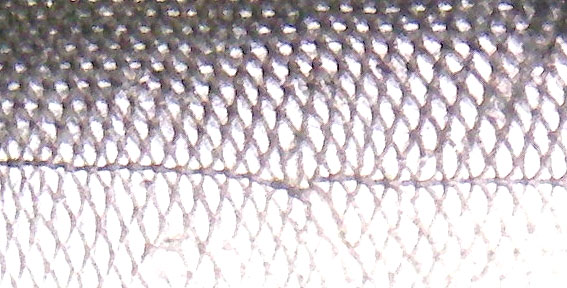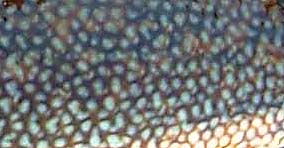 '
'Information Page.
Only skin deep.
Peer in to the window of any fishing tackle shop and your attention is sure to be attracted by the colourful display of lures and flies. Many of these ‘imitations’ are clearly intended to represent living creatures and the majority of them bear a passing resemblance to various species of fish. There are metallic lustres, fins, tails, eyes and streamlined fishy shapes, all faithfully copied. However, the one feature which manufactures seem to ignore is natural colour. Chartreuse, fluorescent orange, day-glo green and yellow, shocking pink, in fact, almost any hue, except seaweed brown or limestone grey, seems to be the order of the day.
Of course the subject of colour and “what fish see” has been discussed ad nauseam in angling magazines and can be sure to rouse heated arguments among any group of anglers. It is certain that predators such as pollack, coalfish, bass and cod will at times, grab anything that’s going whether it be coloured like a sand eel or sky blue pink.
What does this mean? Let’s examine the real facts of the matter and try to decide whether there is a sensible course of action or whether things are really as confusing as many would have us believe. First, what governs the colour of a fish? It must be obvious to anyone that most species are concerned mainly with camouflage. Just look at the inhabitants of sandy sea beds; plaice, dabs, sole, dragonets, spotted rays, dogfish and gobies are all decorated with variations on pepper and salt. Are there any exceptions? Well, there are forms like the sand eels which, although they occur in sand, are bright silver, blue and green. In fact this tells us that these little, glistening, ‘pencil-fish’ normally spend their days in the upper layers of the sea, only returning to their sandy resting places in the dark when colour is unimportant.
The matter of light and daytime coloration brings us to one of the most interesting aspects of fish fancy dress. Many species not only colour differently but also behave differently under cover of darkness. The normal pattern is for fish to school fairly tightly in daylight and then to disperse at night. Rather few species are inclined to form shoals when light levels are low. There is also a strong tendency for many types to move into shallow water at night. Diurnal fish (those which are active when the sun is up) often adopt barred or mottled camouflage patterns at night. This form of cover is seen not only in our own sea fishes but is widespread in tropical seas and in freshwater lakes as well. In contrast, strong length-wise stripes such as those shown by sandsmelts and some wrasses often fade away at night.
What about fish which live in deep water where the darkness is permanent? Many species from the abyssal depths of the ocean (far below the reach of the longest fishing line) are coloured either black or red. In fact the muddy sea bed of the ocean may not be as dark as you would think, because luminescent bacteria produce a pale glow over the sediments. Instead of the coloured spots and stripes of near-surface species these deep sea dwellers have rows of phosphorescent ‘lamps’ along their sides which act as recognition signals. Others may have little blinds which ‘black-out’ the lamps when they are not in use. Some of the most abundant deep sea fishes migrate, at night, towards the surface of the sea, and many of these have the bright silver colouring of shallow water pelagic forms. The little hatchet fishes are typical of these migrants and, of the larger species, the hake has similar habits.
The coloration of most of our common sea fish species is, as I said, basically designed for camouflage ; silver for the open water forms and sand, rock or weed-coloured for the others. On top of these “cryptic” colours are often distinctive recognition patterns. With out detailed studies of behaviour it is difficult to say just what the markings mean but strongly contrasting spots (haddock, john dory etc.) may help species to recognise their own kind. In other cases the sexes differ in a striking fashion. The male dragonet has electric blue stripes while its mate is a dowdy brown, the wrasses show all sorts of distinguishing marks, from the black tail spot of the corkwing to the complete colour change and totally different styles of uniform between the sexes of the cuckoo wrasse. In the latter species the male even develops extra pale patches and marks at spawning time.
Colour change is not the prerogative of the wrasses and, in fact, most species are capable of imitating their surroundings in rather the same way as chameleons. How do they do it? Well there are several components involved in fish coloration. Many species have a layer of tiny ‘mirror like’ granules which give the basic metallic glint to the body. On top of the shiny layer are a number of special, branched cells filled with pigment and it is these which give the fish their colours. When the pigment spreads to the tips of the branches the skin of the fish darkens; when it retreats to the centre of the cell the colour pales. Dogfish, skates and rays are quite slow to change colour and their pigment cells are under the influence of hormones. Flatfish, many of which are masters of colour change, are able to transform very quickly because their cells are controlled by the nervous system. They are even able to imitate patterns such as chequer boards and rows of spots.
How does the fish know what colour it must copy? Basically the eyes send messages to the brain and the brain controls the colour cells but in some cases the basic background colour changes in response to light falling on the skin and even blind fish are able to darken and lighten their skins appropriately. Pressure on the skin can make the pigment cells retract and in this way cause the fish to change colour. Next time you lay a cod or a conger on the boards of a boat just notice how it develops pale areas where it is in contact with the woodwork. Fish with damaged nerves may be unable to control the colour of the area served by the damaged tissue. Sharply defined dark stripes or patches often indicate such injuries.
It is rare to see odd coloured fish of any species. Why is this? Well the truth is that any fish which looks different and stands out from its shoal mates is vulnerable. Whether it be an albino or other mutant, whether it has nerves damaged by parasitic disease or whether it is simply a specimen which inherited poor powers of colour change it is likely to be singled out and devoured by predators. This vulnerability of the odd looking fish is one of the main reasons why artificial lures can be so effective. However much effort we make to imitate the natural prey it is unlikely that our models ever manage to look like much more than a caricature of the real thing and perhaps this is the real secret of success?
If you have any comments or questions about fish, methods, tactics or 'what have you.'get in touch with me by sending an E-MAIL to - docladle@hotmail.com
Bass
 '
'Mackerel.
 '
'Pollack.
 '
'Ballan wrasse.
 '
'